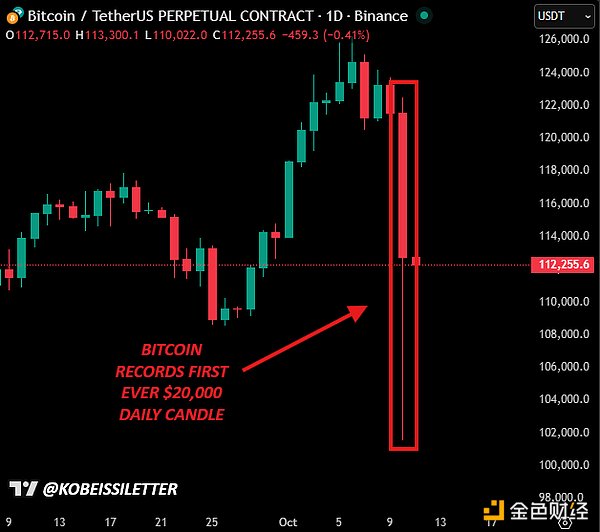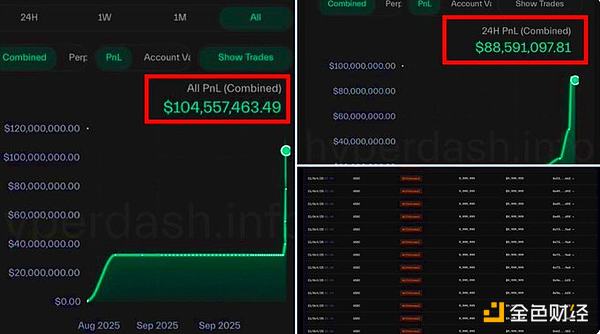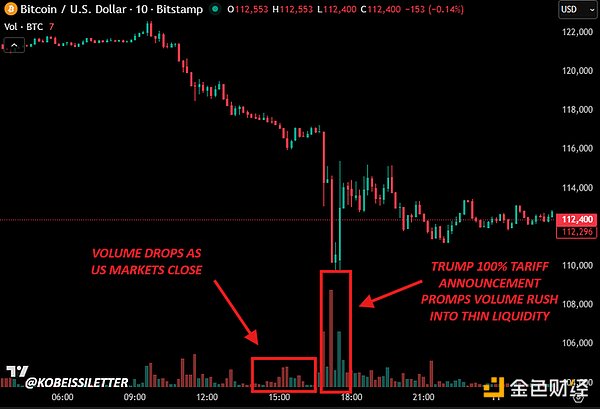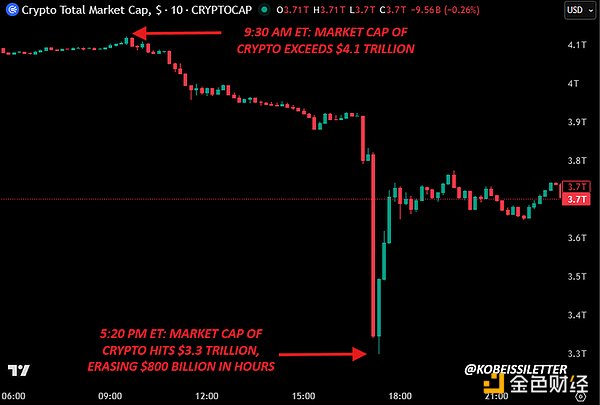Source: The Kobeissi Letter; Compiled by Jinse Finance. The cryptocurrency market experienced its largest liquidation event in history on October 11th, with 1.6 million traders liquidated. Over $19 billion in leveraged cryptocurrency positions were liquidated within 24 hours, nine times the previous record. Why did this happen? Let us explain. To put this into perspective: the liquidations we've seen in the past 24 hours are approximately $17 billion larger than the February 2025 crash and over 19 times larger than the FTX crash in March 2020. History has never seen an event of this magnitude. During the liquidation period, Bitcoin's daily candlestick chart saw a swing of $20,000. This means Bitcoin's market capitalization fluctuated by $380 billion in a single day. This exceeds the combined market capitalization of all but 25 publicly listed companies in the world. This has never happened before.

But why did this happen?
Timeline
To better understand, take a look at the timeline below:
Cryptocurrencies began selling off at 9:50 AM ET, well before Trump’s tariff announcement at 10:57 AM ET.
A large “whale” began shorting cryptocurrencies at 4:30 PM ET.
At 4:50 PM ET, Trump announced a 100% tariff on Chinese goods. The first question is, how did this whale time the decline so precisely? By 5:20 p.m. ET, just 30 minutes after Trump announced the tariffs, liquidations totaled $19.5 billion. Following the plunge, short positions were quickly closed, resulting in a profit of $192 million.

However, there's more to the story.
The main cause of the large liquidations appears to be a combination of excessive leverage and high risk.
If you look at the breakdown of liquidations, you'll see a significant skew towards long positions. Long positions saw $16.7 billion liquidated, while short positions saw approximately $2.5 billion liquidated. The ratio between the two was 6.7:1. Further evidence of excessive long leverage in the market: With the exception of Bitfinex, all major exchanges have high long liquidation ratios. Most exchanges have long positions exceeding 90%, with Hyperliquid alone holding $10.3 billion. This is also true for Hyperliquid, used by whales. The next factor is the "shock effect." Following a historic rally from the April 2025 low, the market became overcrowded with investors favoring long positions. As shown in the chart below, the Greed Index exceeded 60 a few days before the crash. The sudden shock of the tariff announcement caused a dramatic shift in market sentiment. Liquidity is the next issue: Trump's announcement came 50 minutes after the U.S. stock market closed on Friday. As we often see, Friday and Sunday nights are typically characterized by significant volatility in the cryptocurrency market. What's the reason? Because of insufficient liquidity.
The sudden surge in trading volume following Trump's announcement triggered a domino effect.

What happens next?
We believe this plunge is the result of a combination of sudden technical factors. It will not impact long-term fundamentals.
A technical correction was long overdue. We believe a trade deal will eventually be reached, and the cryptocurrency market remains strong. We are bullish. This week's rebound in volatility presents opportunities for investors. Macroeconomic changes are underway, and stocks, commodities, bonds, and cryptocurrencies all offer investment value. Yesterday's plunge reminded us how fragile and yet lucrative markets have become. Between 9:30 AM and 5:20 PM ET, $800 billion in cryptocurrency market capitalization evaporated. Stay objective and capitalize on volatility.

 Catherine
Catherine











